2021 VOLKSWAGEN ID.4 warning light
[x] Cancel search: warning lightPage 163 of 417
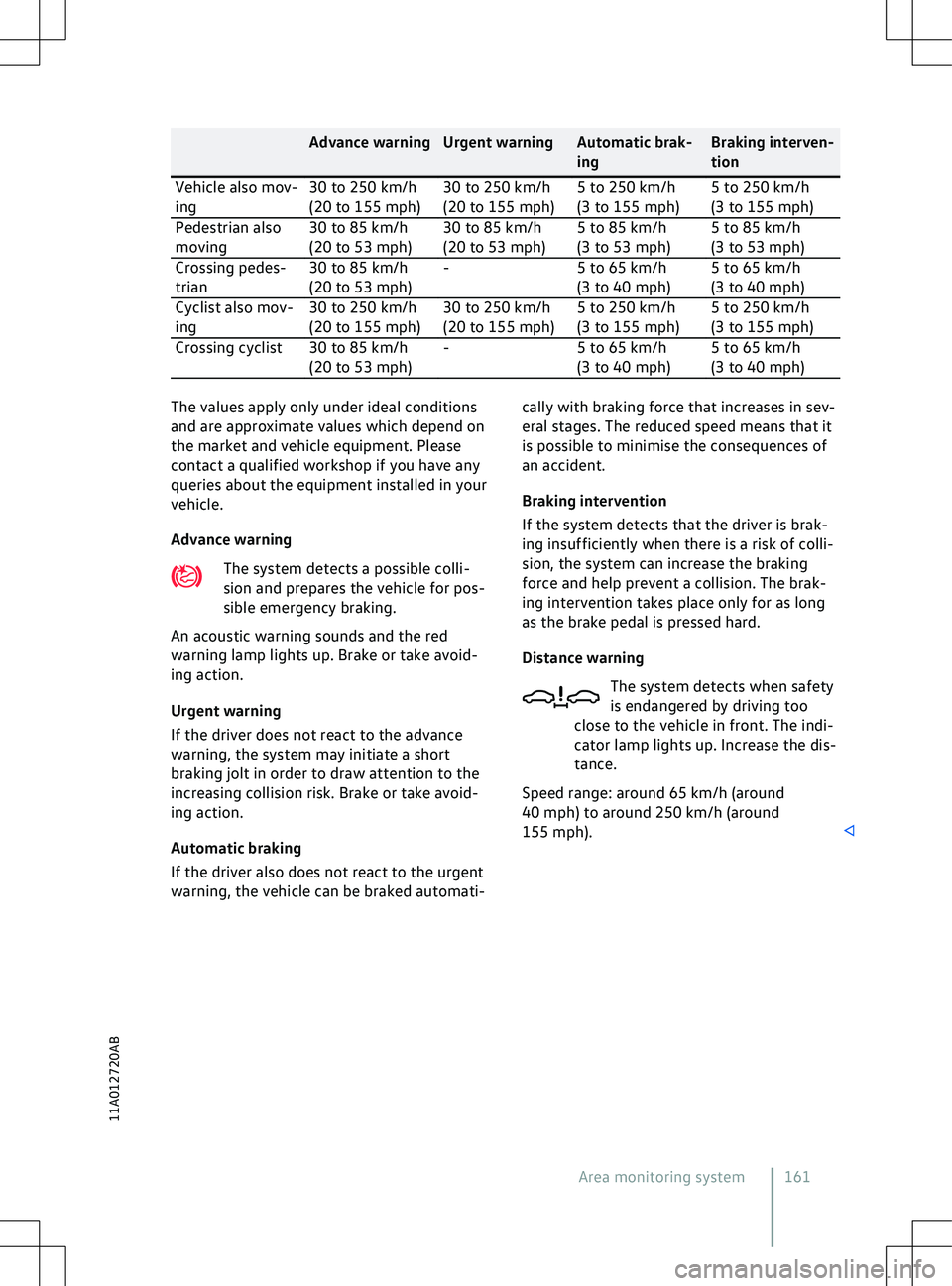
Advance warning Urgent warning Automatic brak-
ingBraking interven-
tion
Vehicle also mov-
ing 30 to 250 km/h
(20 to 155 mph)30 to 250 km/h
(20 to 155 mph)5 to 250 km/h
(3 to 155 mph)5 to 250 km/h
(3 to 155 mph)
Pedestrian also
mo ving 30 to 85 km/h
(20 to 53 mph) 30 to 85 km/h
(20 to 53 mph)5 to 85 km/h
(3 to 53 mph)5 to 85 km/h
(3 to 53 mph)
Crossing pedes-
trian 30 to 85 km/h
(20 to 53 mph)-
5 to 65 km/h
(3 to 40 mph)5 to 65 km/h
(3 to 40 mph)
Cyclist also mov-
ing 30 to 250 km/h
(20 to 155 mph)30 to 250 km/h
(20 to 155 mph)5 to 250 km/h
(3 to 155 mph)5 to 250 km/h
(3 to 155 mph)
Crossing cyclist 30 to 85 km/h (20 to 53 mph)-
5 to 65 km/h
(3 to 40 mph)5 to 65 km/h
(3 to 40 mph)The values apply only under ideal conditions
and are appro
ximate values which depend on
the market and vehicle equipment. Please
contact a qualified workshop if you have any
queries about the equipment installed in your
vehicle.
Advance warning
The system detects a possible colli-
sion and prepares the vehicle for pos-
sible emergency braking.
An acoustic warning sounds and the red
warning lamp lights up. Brake or take avoid-
ing action.
Urgent warning
If the driver does not react to the advance
warning, the system may initiate a short
braking jolt in order to draw attention to the
increasing collision risk. Brake or take avoid-
ing action.
Automatic braking
If the driver also does not react to the urgent
warning, the vehicle can be braked automati- cally with braking force that increases in sev-
eral stages. The reduced speed means that it
is possible to minimise the consequences of
an accident.
Braking interv
ention
If the system detects that the driver is brak-
ing insufficiently when there is a risk of colli-
sion, the system can increase the braking
force and help prevent a collision. The brak-
ing intervention takes place only for as long
as the brake pedal is pressed hard.
Distance warning
The system detects when safety
is endangered by driving too
close to the vehicle in front. The indi-
cator lamp lights up. Increase the dis-
tance.
Speed range: around 65 km/h (around
40 mph) to around 250 km/h (around
155 mph). Area monitoring system 161
11A012720AB
Page 176 of 417
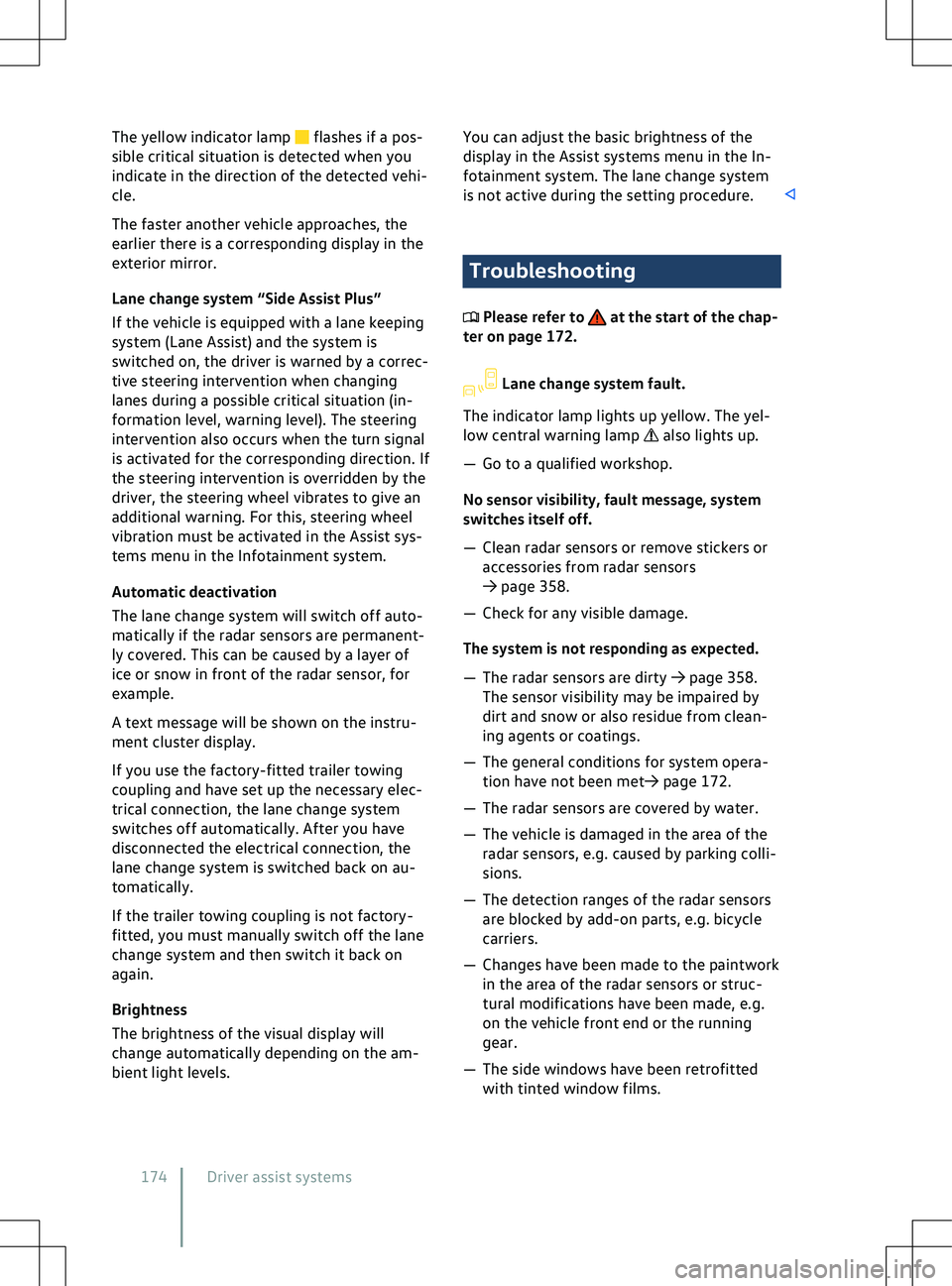
The yellow indicator lamp flashes if a pos-
sible critical situation is detected when you
indicate in the direction of the detected v
ehi-
cle.
The faster another vehicle approaches, the
earlier there is a corresponding display in the
exterior mirror.
Lane change system “Side Assist Plus”
If the vehicle is equipped with a lane keeping
system (Lane Assist) and the system is
switched on, the driver is warned by a correc-
tive steering intervention when changing
lanes during a possible critical situation (in-
formation level, warning level). The steering
intervention also occurs when the turn signal
is activated for the corresponding direction. If
the steering intervention is overridden by the
driver, the steering wheel vibrates to give an
additional warning. For this, steering wheel
vibration must be activated in the Assist sys-
tems menu in the Infotainment system.
Automatic deactivation
The lane change system will switch off auto-
matically if the radar sensors are permanent-
ly covered. This can be caused by a layer of
ice or snow in front of the radar sensor, for
example.
A text message will be shown on the instru-
ment cluster display.
If you use the factory-fitted trailer towing
coupling and have set up the necessary elec-
trical connection, the lane change system
switches off automatically. After you have
disconnected the electrical connection, the
lane change system is switched back on au-
tomatically.
If the trailer towing coupling is not factory-
fitted, you must manually switch off the lane
change system and then switch it back on
again.
Brightness
The brightness of the visual display will
change automatically depending on the am-
bient light levels. You can adjust the basic brightness of the
display in the Assist systems menu in the In-
f
otainment system. The lane change system
is not active during the setting procedure. Troubleshooting
Please refer to at the start of the chap-
ter on page 172. Lane change system fault.
The indicator lamp lights up yellow. The yel-
low central warning lamp also lights up.
Page 195 of 417
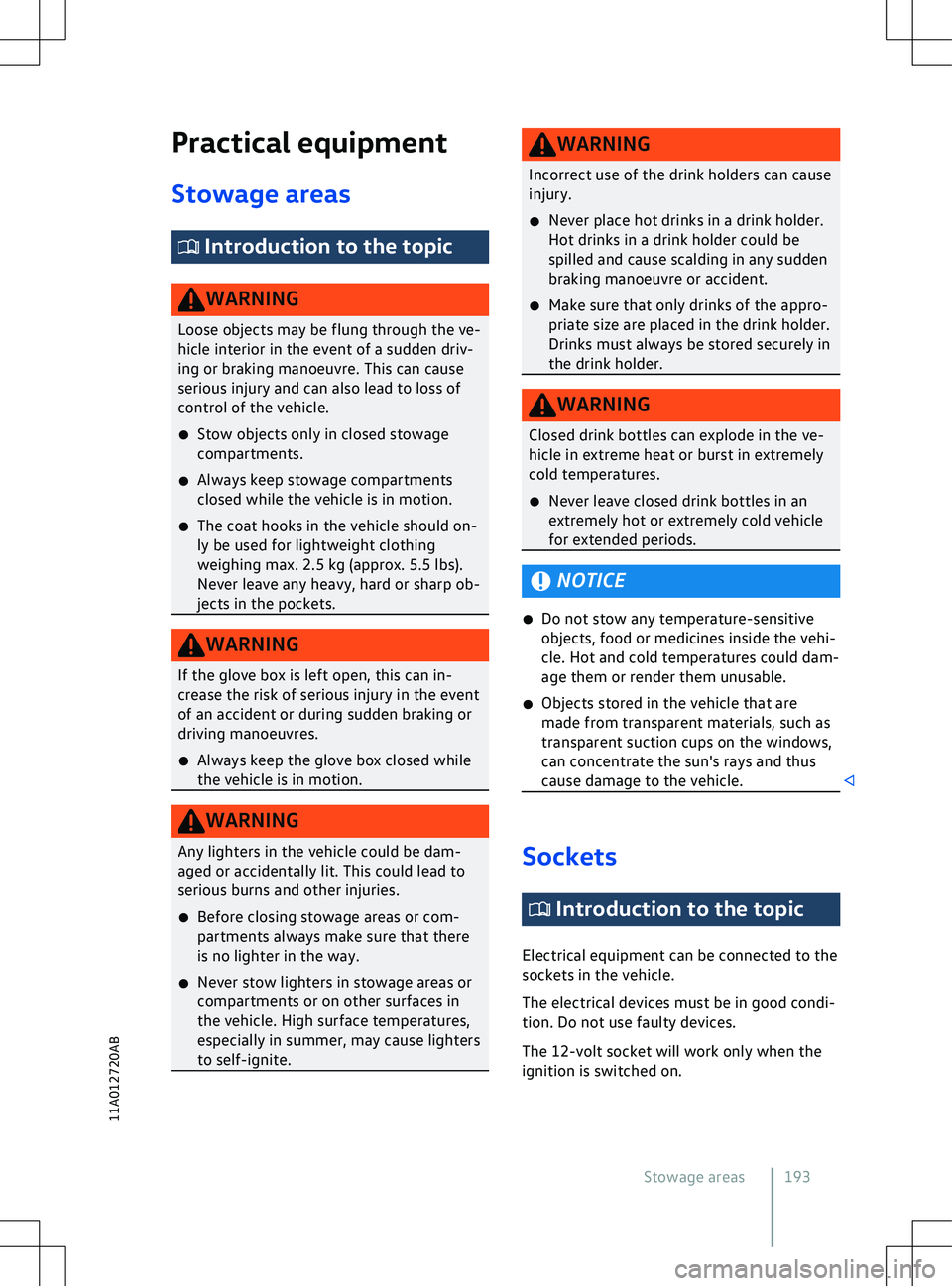
Practical equipment
Stowage areas Introduction to the topic
WARNING
Loose objects may be flung through the ve-
hicle interior in the e vent of a sudden driv-
ing or braking manoeuvre. This can cause
serious injury and can also lead to loss of
control of the vehicle.
�x Stow objects only in closed stowage
compartments.
�x Always keep stowage compartments
closed while the vehicle is in motion.
�x The coat hooks in the vehicle should on-
ly be used for lightweight clothing
weighing max. 2.5 kg (approx. 5.5 lbs).
Never leave any heavy, hard or sharp ob-
jects in the pockets. NOTICE
�x Do not stow any temperature-sensitiv
e
objects, food or medicines inside the vehi-
cle. Hot and cold temperatures could dam-
age them or render them unusable.
�x Objects stored in the vehicle that are
made from transparent materials, such as
transparent suction cups on the windows,
can concentrate the sun
Page 262 of 417
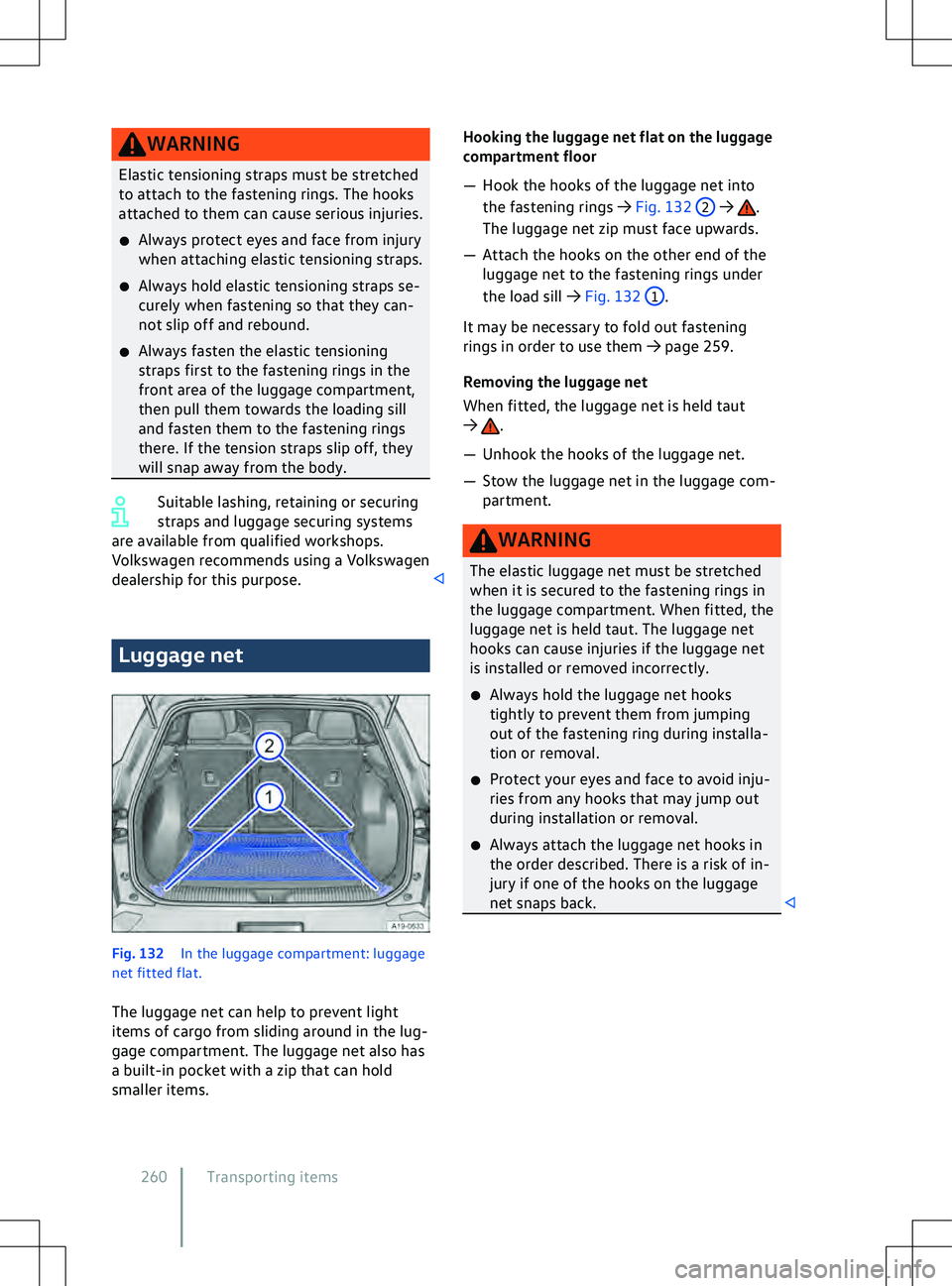
WARNING
Elastic tensioning straps must be stretched
to attach to the fastening rings. The hooks
attached to them can cause serious injuries.
�x Always protect eyes and face from injury
when attaching elastic tensioning straps.
�x Always hold elastic tensioning straps se-
curely when fastening so that they can-
not slip off and rebound.
�x Always fasten the elastic tensioning
straps first to the fastening rings in the
front area of the luggage compartment,
then pull them towards the loading sill
and fasten them to the fastening rings
there. If the tension straps slip off
, they
will snap away from the body. Suitable lashing, retaining or securing
straps and luggage securing systems
are a
vailable from qualified workshops.
Volkswagen recommends using a Volkswagen
dealership for this purpose. Luggage net
Fig. 132
In the luggage compartment: luggage
net fitted flat.
The luggage net can help to pre
vent light
items of cargo from sliding around in the lug-
gage compartment. The luggage net also has
a built-in pocket with a zip that can hold
smaller items. .
The luggage net zip must face upwards.
Page 307 of 417
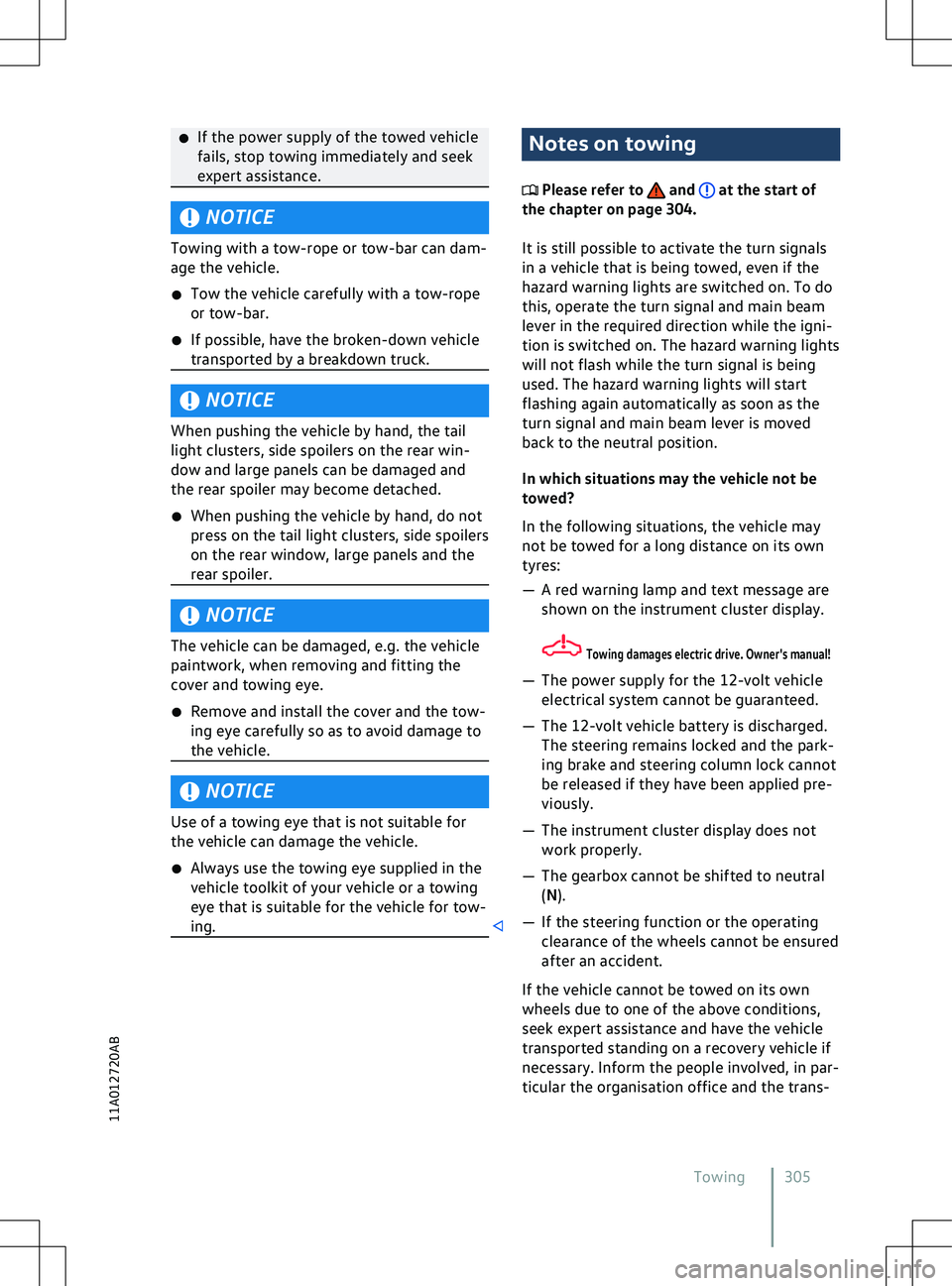
�x
If the power supply of the towed v ehicle
fails, stop towing immediately and seek
expert assistance. NOTICE
Towing with a tow-rope or tow-bar can dam-
age the v
ehicle.
�x Tow the vehicle carefully with a tow-rope
or tow-bar.
�x If possible, have the broken-down vehicle
transported by a breakdown truck. NOTICE
When pushing the vehicle by hand, the tail
light clusters, side spoilers on the rear win-
dow and large panels can be damaged and
the rear spoiler may become detached.
�x When pushing the v
ehicle by hand, do not
press on the tail light clusters, side spoilers
on the rear window, large panels and the
rear spoiler. NOTICE
The vehicle can be damaged, e.g. the vehicle
paintwork, when remo
ving and fitting the
cover and towing eye.
�x Remove and install the cover and the tow-
ing eye carefully so as to avoid damage to
the vehicle. NOTICE
Use of a towing eye that is not suitable for
the v
ehicle can damage the vehicle.
�x Always use the towing eye supplied in the
vehicle toolkit of your vehicle or a towing
eye that is suitable for the vehicle for tow-
ing. Notes on towing
Please refer to and at the start of
the chapter on page 304.
It is still possible to activ
ate the turn signals
in a vehicle that is being towed, even if the
hazard warning lights are switched on. To do
this, operate the turn signal and main beam
lever in the required direction while the igni-
tion is switched on. The hazard warning lights
will not flash while the turn signal is being
used. The hazard warning lights will start
flashing again automatically as soon as the
turn signal and main beam lever is moved
back to the neutral position.
In which situations may the vehicle not be
towed?
In the following situations, the vehicle may
not be towed for a long distance on its own
tyres:
Page 404 of 417

Fastening rings
259
Fault memory see Event memory 367
Filling Safety notes 309
Fire What to do 67
Fire extinguisher 69
First-aid box see First-aid kit 68
First-aid kit 68
Storage location 68
First-aid pack see First-aid kit 68
Floor mats 129
Frequency bands 232
Front airbags see Airbag system 52
Front Assist 159
Advance warning 161
Camera 159
Cyclist monitoring 163
Distance warning 161
Oncoming vehicle braking when turn- ing 164
Operating 164
Pedestrian Monitoring 163
Problem solving 165
Radar sensor 159
Swerve support 163
Switching off 164
System boundaries 162
Urgent warning 161
Front compartment 309
Vehicle battery (12-volt) 320
Front passenger exterior mirror lowering
function 117
Front passenger front airbag see Airbag system 47
Switching off with key-operated switch 53
Front seats 93
Electrical controls 95
Electrically adjusting 95
Mechanical controls 94
Mechanically adjusting 94
Function buttons Area View 182
Manoeuvre braking 181
Park Distance Control 181
Parking systems 181Rear view camera system
181
Fuses 296
Changing 300
Colour coding of fuses 301
Detecting a blown fuse 301
In the bonnet space 298
In the dash panel 299
Preparation for changing 301
Types 300
G
General notes 32
Glass roof Sun blind in the glass roof 119
Gradient angle 387
Gross combination weight Information 387
H Handbrake see Parking brake 177
Hazard warning lights 66
Head restraint 99
Head restraints 98
Removing and installing 99
Head-up display 21
Adjusting 22
Adjusting the height 22
Display areas 21
Switching off 22
Switching on 22
Headlight range control 109
Headlights Driving abroad 110
Heated seats see Air conditioning system 124
Help apps 203
Help for mobile online services 203
High-visibility waistcoat 68, 69
High-voltage battery 273
AC charging 281
Battery capacity 275, 391, 392
Battery care 276
Battery charge limits 277
Care instructions 275, 276
Charge level 19
Charging 279
Charging power 391, 392
Charging process display 284
Charging settings 276
402 Index
Page 405 of 417

Current identification
281
DC charging 283
External energy management 278
Frost 276
Immediate charging 276
Off-peak tariff online 278
Outside temperatures 276
Preferred charging times 278
Range 19
Reducing the charging current 278
Releasing the charging connec- tor 278
Reserve range 19
Safety instructions 273
Setting charging locations 278
Start screen 276
Timer-controlled charging 276
Vehicle standing times 276
High-voltage system Safety instructions 273
Warning signs 274
Hill Start Assist See Auto Hold function 178
Hood see Bonnet 312
How do I activate We Connect? 203
How do I connect my vehicle? 203
How do I use the We Connect service? 203
Hubcaps 341
Centre wheel trim 341
Wheel bolt caps 342
Wheel cover 342
I
Ice remo val
see Defrost function 121
ID. Cockpit Digital instrument cluster 18
Displays 22
Event in the ID. Cockpit 18
Views 19
ID. Light 31
Displayed information 31
Settings 31
Identification number 387
Position 388
Ignition Switching off the ignition 137
Switching on the ignition 137
Immobiliser 139
Indicator lamp Active charging process
284
Charging active 282
Charging connector plugged in 283
Electromechanical brake servo 191
Indicator lamps ABS 191
Airbag system 49
Ball coupling 267
Brake pad wear indicator 131
Brake support systems 191
Central locking 78
ESC 191
In the driver door 78
Overview 15
Position selection 142
Seat belts 37
Steering column lock 143
Tyre monitoring system 327
Infotainment Function buttons 225
Getting started 217
Media mode 234
Mobile phone interface 246
Navigation 238
Radio 231
Radio mode 231
Sound settings 226
System settings 226
Infotainment system 217
Adapting menus 225
aerials 371
Before using for the first time 217
Charging settings (high-voltage bat- tery) 276
Cleaning 227
Control centre 225
Controls and display 30
Drop-down menu 225
Notes on use 220
Operating 224
Overview 222
Personalising 225
Safety notes 218
Setting battery charge limits 277
Setting charging locations 278
Start screen 222, 224
Switching on and off 224
Tiles 225
Time and date 29
Vehicle settings menu 31
Infotainment systems
Index 403
11A012720AB
Page 406 of 417
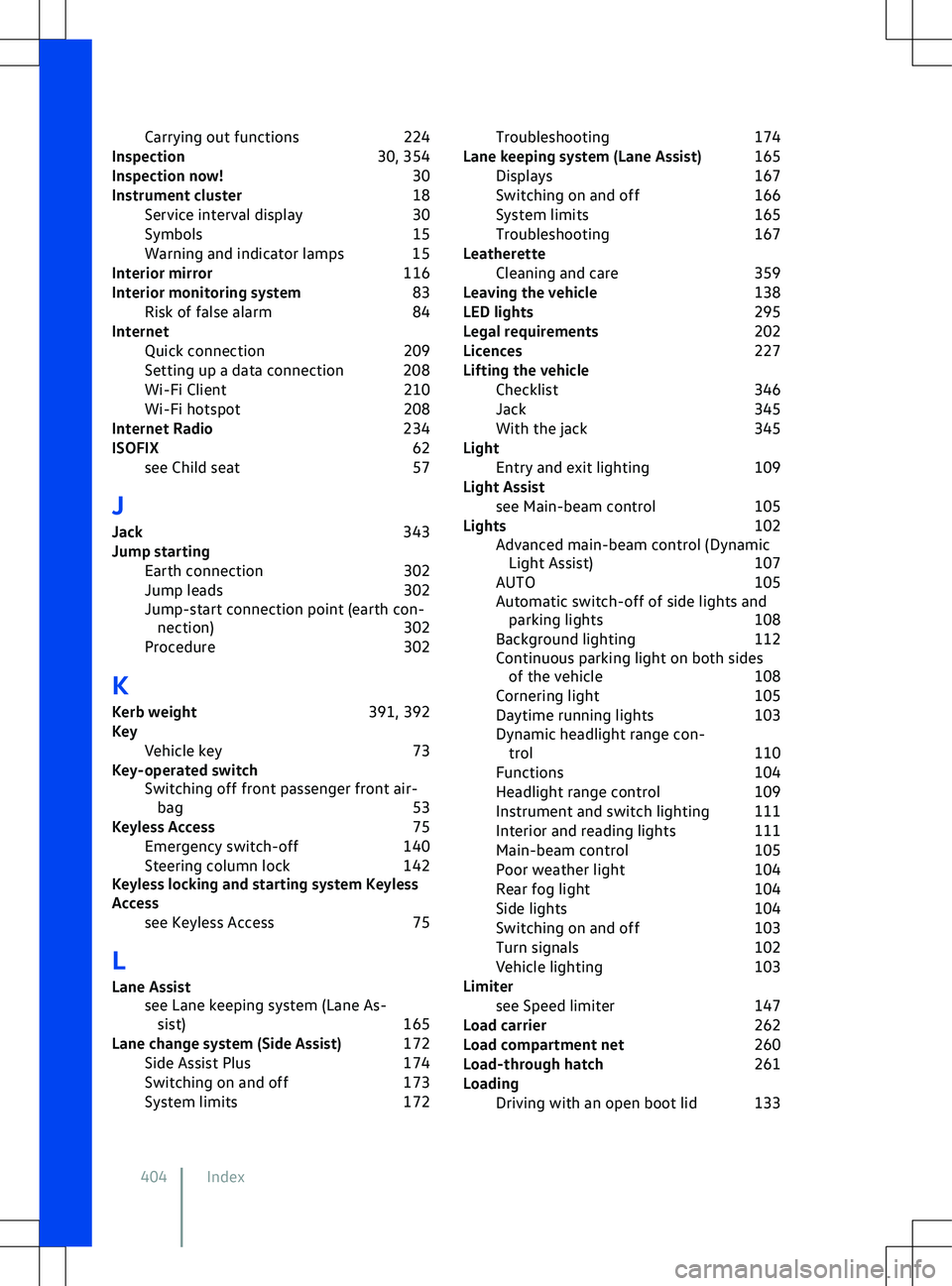
Carrying out functions
224
Inspection 30, 354
Inspection now! 30
Instrument cluster 18
Service interval display 30
Symbols 15
Warning and indicator lamps 15
Interior mirror 116
Interior monitoring system 83
Risk of false alarm 84
Internet Quick connection 209
Setting up a data connection 208
Wi-Fi Client 210
Wi-Fi hotspot 208
Internet Radio 234
ISOFIX 62
see Child seat 57
J
Jack 343
Jump starting Earth connection 302
Jump leads 302
Jump-start connection point (earth con- nection) 302
Procedure 302
K Kerb weight 391, 392
Key Vehicle key 73
Key-operated switch Switching off front passenger front air-bag 53
Keyless Access 75
Emergency switch-off 140
Steering column lock 142
Keyless locking and starting system Keyless
Access
see Keyless Access 75
L
Lane Assist see Lane keeping system (Lane As-sist) 165
Lane change system (Side Assist) 172
Side Assist Plus 174
Switching on and off 173
System limits 172Troubleshooting
174
Lane keeping system (Lane Assist) 165
Displays 167
Switching on and off 166
System limits 165
Troubleshooting 167
Leatherette Cleaning and care 359
Leaving the vehicle 138
LED lights 295
Legal requirements 202
Licences 227
Lifting the vehicle Checklist 346
Jack 345
With the jack 345
Light Entry and exit lighting 109
Light Assist see Main-beam control 105
Lights 102
Advanced main-beam control (Dynamic Light Assist) 107
AUTO 105
Automatic switch-off of side lights and parking lights 108
Background lighting 112
Continuous parking light on both sides of the v ehicle 108
Cornering light 105
Daytime running lights 103
Dynamic headlight range con- trol 110
Functions 104
Headlight range control 109
Instrument and switch lighting 111
Interior and reading lights 111
Main-beam control 105
Poor weather light 104
Rear fog light 104
Side lights 104
Switching on and off 103
Turn signals 102
Vehicle lighting 103
Limiter see Speed limiter 147
Load carrier 262
Load compartment net 260
Load-through hatch 261
Loading Driving with an open boot lid 133
404 Index